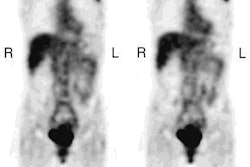
In the Journal of Ultrasound in Medicine, breast imagers from South Korea report on a rare case of benign hemangioma. What made this case particularly interesting was that the patient presented with skin redness, which confounded the radiologists during their initial assessment. Fortunately, sonography was able to pinpoint the nature of the problem.
The 29-year-old patient had a two-year history of a slow-growing palpable mass in the right breast, wrote Dr. Sun Yang Chung and Dr. Ki Keun Oh. Chung is from the College of Medicine, Pochon Cha University in Kyonggi. Oh is from the Yonsei University College of Medicine in Seoul.
 |
| Ultrasound reveals a lobulated, hypoechoic nodule with a microlobulated margin and an uneven echogenic boundary. The nodule is located in the subcutaneous layer. |
The physical exam revealed a soft, non-tender nodule with an irregular margin 1 cm in diameter. A small area of skin redness was visible over the area of the palpable nodule. Mammography showed a 1-cm lobulated, isodense nodule with a poorly defined margin in the upper anterior region of the right breast.
 |
| Power Doppler sonogram shows increased vascularity in tumor. Images courtesy of Dr. Sun Yang Chung. |
Traditional sonography revealed a lobulated, hypoechoic nodule with a microlobulated margin and an uneven echogenic boundary. Power Doppler ultrasound-guided core-needle biopsy, surgical excision, and a histologic exam revealed the hemangioma.
The authors guessed that the skin redness was induced either by focal skin involvement of breast cancer or unknown blunt trauma, and suggested that skin redness could be added to the list of findings associated with this type of hemangioma (JUM, May 2002, Vol.21:5, pp. 585-588).
Investigators from Beth Israel Deaconess Medical Center in Boston also found sonography useful in the case of a 42-year-old woman who presented with a round, firm 5-mm lump in the lower inner quadrant of her right breast. No mass was identified on the mammogram.
The ultrasound exam was done on an HDI 3000 scanner (Philips Medical Systems, Andover, MA) with a 10-5 MHz compact linear-array transducer. An ovoid mass was found in the subcutaneous fat, anterior to the most anterior layer of the superficial pectoral fascia, stated Dr. Bettina Siewert and co-authors in the American Journal Roentgenology (April 2002, Vol. 178:4, pp.1025-1027).
The lesion's margin was distinct, smooth, and thin. The mass also was homogenous in echotexture and was hypoechnoic to the surrounding fat. Power Doppler imaging identified minimal vascular flow. At 2 months' follow-up, the lesion was still palpable and unchanged on sonography; the patient elected surgical removal.
"The differential diagnosis included hematoma in the subcutaneous soft tissues and early sebaceous cyst not yet involving the dermis," the authors wrote. "Localizing a lesion and its relationship to adjacent tissues aids in accurately formulating a differential diagnosis...a primary breast mass, in particular, breast cancer, can be excluded from the differential diagnosis."
By Shalmali PalAuntMinnie.com staff writer
October 16, 2002
Related Reading
Ultrasonography improves cancer screening of dense breasts, September 20, 2002
US targets additional, unsuspected lesions in dense breasts, September 9, 2002
Copyright © 2002 AuntMinnie.com



















